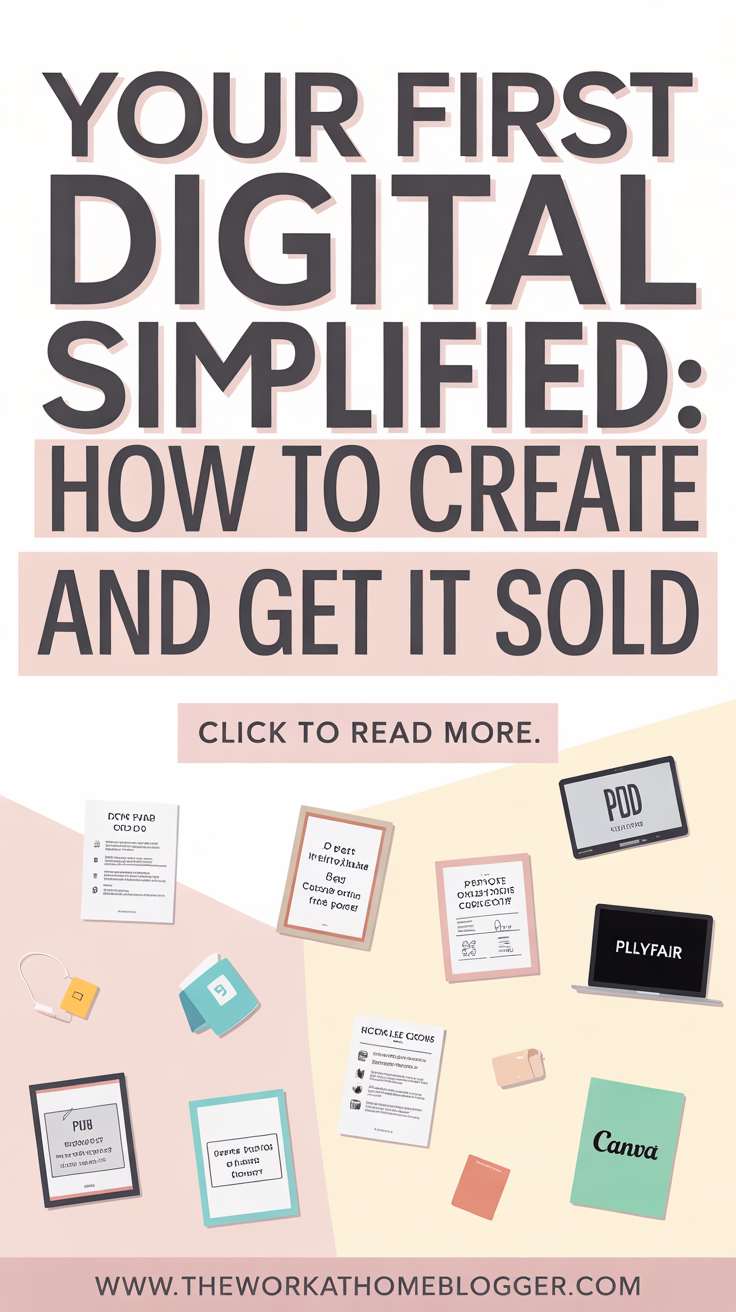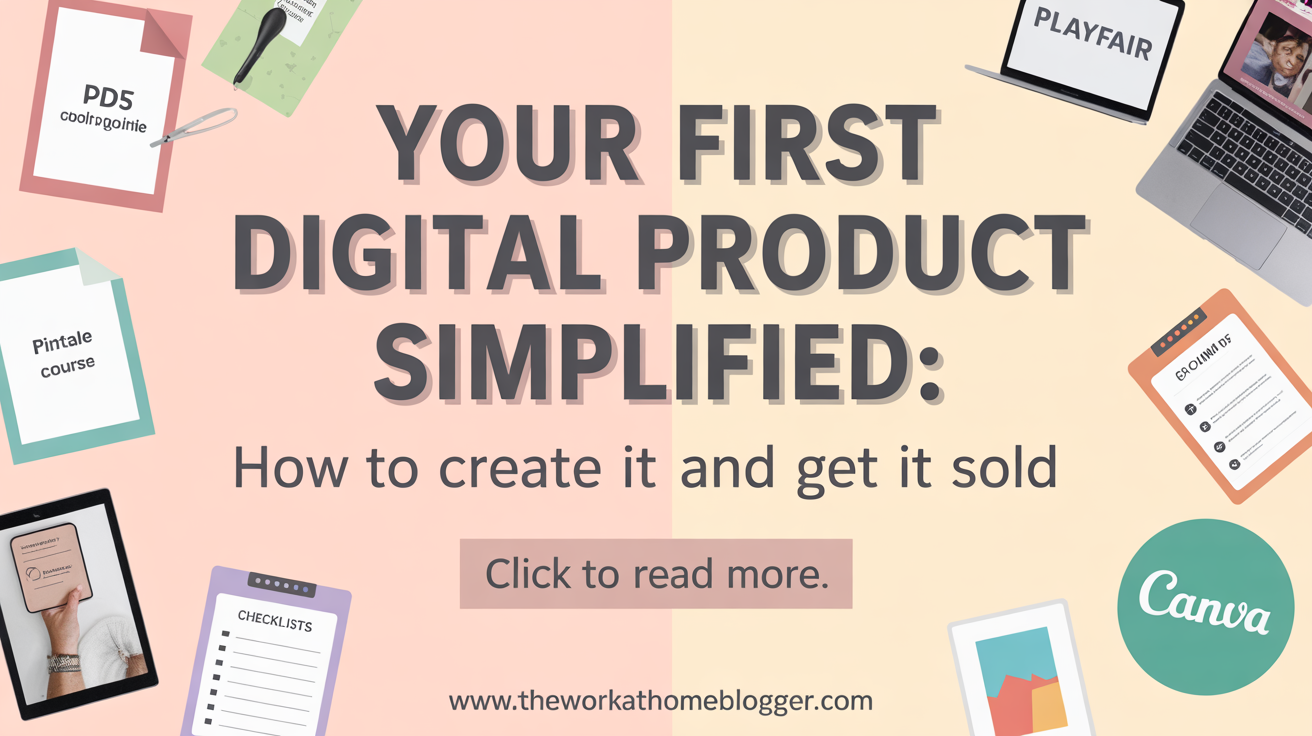Want to create your first digital product idea into real income? You’re in the right place. Over the years, I’ve learned what works (and doesn’t) when creating and marketing digital products. In this post, I’ll walk you through the basics—from choosing your idea to getting it in front of the right people. Whether you’re just starting or feeling a little stuck, these simple but powerful steps can help you build something valuable and get it sold. Let’s break it down together!
Key Takeaways:
- Identify your target audience and their pain points to create a valuable digital product that meets their needs.
- Utilize various marketing strategies, such as social media, email campaigns, and content marketing, to effectively promote your digital product.
- Continuously gather feedback and analyze sales data to improve your product and adjust your marketing strategies for better results.
How to Create and Market Your First Digital Product
Transforming Ideas into Digital Gold

Every great digital product starts with a simple idea—but turning that idea into something people want? That’s where the magic happens. The key is understanding what your audience truly needs. When you take the time to listen, ask questions, and get clear on their struggles, you can shape your idea into a real solution. That’s how you go from just “an idea” to a digital product that stands out and sells.
Identifying Market Gaps and Pain Points
If you want your product to succeed, you must solve a problem that’s bothering people. Look at your niche’s customer reviews, social media comments, and online forums. What are people complaining about? What do they wish existed? These are clues. When you spot a common pain point that no one’s fixing, you’ve found your golden opportunity to create something that genuinely helps—and people will pay for that.
Crafting Your Unique Value Proposition
Your Unique Value Proposition (UVP) makes your product stand out. It answers every buyer’s big question: “Why should I choose your product instead of someone else’s?” It’s not just about what your product is—it’s about the value it brings and how it solves a specific problem better than the rest.
To figure out your UVP, look at two things: what your product does well and what your audience struggles with. Let’s say your competitors charge a lot, but offering something just as good for a lower price is part of your UVP. Maybe you deliver faster or provide better support—that’s part of it, too. People are more likely to buy when you communicate what makes your product the more intelligent choice. It’s that simple.
Building a Seamless User Experience
A smooth and easy-to-use product makes a big difference. People won’t stick around if your digital product is confusing, slow, or hard to navigate. That’s why it’s important to keep things simple, fast, and user-friendly.
Make sure everything loads quickly, buttons are easy to find, and the layout makes sense. Clear instructions and clean design help users feel confident and stay engaged. When it looks good and works well, users are more likely to come back and recommend it to others.
Designing for Everyone: Make It Easy and Engaging
Your digital product should work for everyone, no matter their abilities. That means making it easy to use with a keyboard, readable by screen readers, and giving options like larger text for those who need it. These small changes can make a big difference—and help more people use (and love) your product.
But accessibility isn’t just about function—it’s also about fun! Add a simple, eye-catching design and features that are easy to click or tap. When your product is both inclusive and engaging, people are more likely to stick around and come back for more.
Testing, Tweaking, and Listening to Your Users
No product is perfect right out of the gate—that’s why testing is so important. The best way to improve your digital product is to get real feedback from real users and use that info to make smart changes.
You can do this through surveys, quick interviews, or tools like Hotjar that show how people are using your product. These insights help you spot what’s working and what’s not—so you can fix it fast.
Think of your product as something that grows and evolves. When you listen to your audience and make updates based on their needs, you’re not just improving the product—you’re building trust and loyalty. And that’s what keeps people coming back.
Setting the Right Price: A Mix of Strategy and Gut Feeling
Pricing your digital product isn’t just about making back what you spent—it’s about finding the sweet spot between what you think it’s worth and what your audience is willing to pay. You want it to feel like a great deal, without underpricing yourself.
Try different price points to see what works best. Sometimes, small changes can make a big difference in sales. Watch how people respond and be ready to adjust. The goal is to earn a profit while keeping your product affordable and attractive to your audience.
Using Smart Pricing Tricks That Work
Believe it or not, how you price your product can affect whether someone buys it—without them even realizing why. People often shop based on feelings, not logic. For example, pricing something at $9.99 instead of $10 makes it seem like a better deal, even though it’s just one cent less.
You can also offer tiered pricing, like a basic version and a premium version. This makes the higher-priced option feel like a better value. These small tricks don’t cheapen your product—they just help people feel more confident when deciding, boosting your sales big time.
Looking at What Your Competitors Charge
Checking out how others price their digital products can teach you a lot. It helps you understand what customers expect to pay, what’s considered a “good deal,” and how to make your product stand out.
Look at things like discounts, payment plans, and if they use smart pricing tricks (like $9.99 instead of $10). Notice what’s working for them—and what’s not.
But don’t stop at the price tag. Ask yourself: Is their product really worth that price? Compare what they offer to what you offer. Read reviews, check social media comments, or even send out a quick survey to see what people value most. This research helps you price your product confidently and competitively.
Crafting a Simple Marketing Plan That Works Everywhere
If you want people to find—and buy—your digital product, you need to be where they are. That’s what a multi-channel marketing strategy is all about. It means showing up in more than one place: on social media, in emails, in search results, and maybe even with online ads.
When all your messages work together across these platforms, it builds trust and makes your brand look polished and professional. The goal is to guide people step-by-step—from learning about your product to buying it, and eventually becoming loyal fans.
Using Social Media to Reach More People
Social media is your best friend when it comes to getting eyes on your digital product. But you don’t have to be on every platform—just the ones where your people hang out. That could be Pinterest, Instagram, TikTok, or even YouTube.
Share helpful content, behind-the-scenes tips, and fun updates. Talk to your audience through stories, posts, or live videos. The more consistent and real you are, the more they’ll see you as someone they can trust—and buy from.
Content That Educates, Entertains, and Sells
Content marketing is one of the most powerful (and affordable) ways to sell without being salesy. Think blog posts, how-to videos, checklists, or even fun infographics. This kind of content builds a connection with your audience while showing off your expertise.
The magic happens when your content speaks directly to their struggles and offers a solution—your product. Share personal stories, answer common questions, and give helpful tips. The more value you give, the more likely people are to trust you and take action.
Fun fact: according to HubSpot, businesses that blog are 13x more likely to see a positive return on investment. So yes, your blog post can lead to real money.
What Happens After the Sale Matters—A Lot
Just because someone bought your digital product doesn’t mean the relationship ends there. In fact, this is where it really starts. Following up with your customers, sending them helpful tips, or giving them special offers makes them feel seen and appreciated.
You could offer a thank-you freebie, early access to something new, or even a small discount for their next purchase. When customers feel valued, they’re more likely to come back—and tell their friends about you too.
Support Is Part of the Experience
No one likes being ignored when they need help. That’s why good customer support is a must. It can be as simple as having a FAQ page, offering email support, or using a tool like Zendesk or Freshdesk to manage questions.
When people know they can count on you to fix a problem, they’re more likely to trust your brand—and buy from you again.
Ask for Feedback and Turn It into Loyalty
Want to know how to make your product better and build loyalty? Just ask your customers what they think. Use a short survey, a feedback form, or even a quick email. Offer a little thank-you gift—like a discount or freebie—to encourage them to respond.
Then, here’s the key: actually use their feedback. Make changes. Show them you’re listening. When people feel heard, they stick around. Bonus? Happy customers often become your best marketers. Share their testimonials and stories to build social proof and attract even more buyers.
Conclusion: Keep It Simple, Keep It Smart
Creating and marketing a digital product doesn’t have to be overwhelming. Start with the basics:
✅ Know who you’re helping
✅ Solve a real problem
✅ Create a great experience
✅ Promote it in smart, simple ways
✅ Keep building the relationship after the sale
Stick with it, test what works, and stay flexible as you grow. Over time, you’ll build not just a product—but a brand people trust and love.
Pro Tip for Your Next Step
Want to find trending product ideas and keywords that people are searching for right now? I highly recommend PinClicks (affiliate link). It’s my go-to tool for spotting high-volume Pinterest searches and planning smart content that drives traffic and sales.
Whether creating your first product or growing your digital shop, PinClicks helps you stay ahead of the game—and build with confidence.
FAQ
Q: What are the first steps in creating a digital product?
A: The first steps in creating a digital product include identifying your target audience and understanding their needs, brainstorming product ideas that provide value, conducting market research to validate your concept, and outlining the features and benefits of your product. This foundational work helps ensure your digital product resonates with potential customers.
Q: How do I choose the right platform to sell my digital product?
A: Choosing the right platform involves considering factors such as your target audience’s preferences, the type of digital product you’re offering (e.g., e-books, courses, software), pricing options, transaction fees, and ease of use. Popular platforms include Shopify, Gumroad, Teachable, and Etsy. Each has its own strengths, so review your options carefully to find the best fit.
Q: What strategies can I use to market my digital product effectively?
A: Effective marketing strategies include leveraging social media to reach your audience, creating a content marketing plan that showcases your expertise, implementing email marketing to nurture leads, collaborating with influencers, and using paid advertising if your budget allows. Building a strong online presence and engaging with your audience can also significantly enhance your product’s visibility and sales.
Q: How can I optimize my digital product for search engines?
A: Optimizing your digital product for search engines involves keyword research to identify relevant terms your potential customers are searching for, incorporating these keywords naturally into your product descriptions and marketing materials, and creating high-quality content that attracts backlinks. Using alt text for images and optimizing your website’s loading speed can improve your search engine rankings.
Q: How can I gather feedback on my digital product?
A: To gather feedback, consider using surveys or questionnaires sent to early users, conducting interviews to gain in-depth insights, and encouraging reviews and testimonials from customers. You can also monitor social media conversations and online forums to understand how your product is perceived. Feedback is vital for making improvements and ensuring customer satisfaction.







